
 |
Tea Clipper |
 |
| from TeaAntiques.com | ||
| Edition Eighty Two |
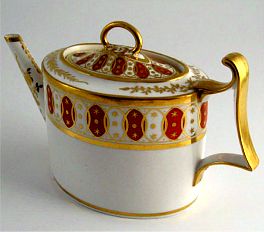 This is a rare and magnificent Derby teapot dating from the end
of the Eighteenth century, c1795. It is of a straight sided oval shape, with
straight spout, angular handle and a cover with an open loop finial.
This is a rare and magnificent Derby teapot dating from the end
of the Eighteenth century, c1795. It is of a straight sided oval shape, with
straight spout, angular handle and a cover with an open loop finial.
The teapot and cover have the most stunning gilt and orange decoration. The gilding is of a very rich honey colour that just shines out beautifully.
The top of the teapot's body has very beautiful gilded foliage that runs round the front and back portion of the teapot's shoulder. The fineness and skill of this applied gilding is amazing.
The spout of the teapot is a straight conical shape and has applied gilt decoration to the sides, top and front. To the sides it has foliage and flowers in gilt. The front and top have delicate gilded foliage. The tip of the spout is gilded, as is round the base of the spout.
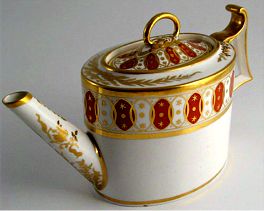
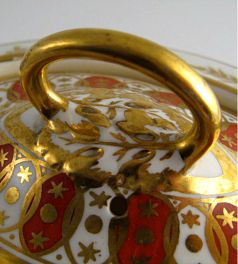
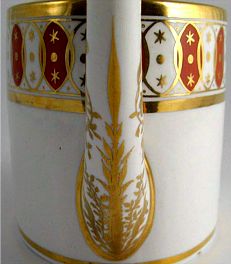
The teapot is marked on the underside with the painted Derby mark of the crown, below which are the crossed batons, between which are three dots to each side. Below this is the 'D' Derby mark and number 616. This mark is executed in puce. This mark together with the shape and style of the teapot dates it to c1795.
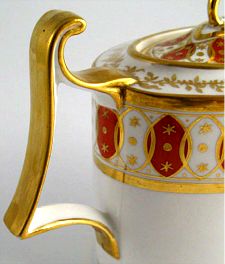
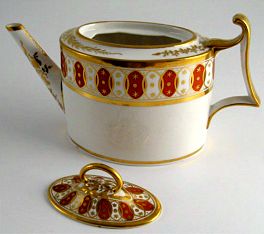
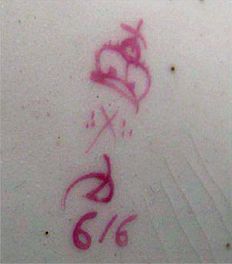
This is a delightful teapot for the connoisseur collector of early English or Derby porcelain.
More details of this item and other tea related antiques can be found by visiting my web site at www.TeaAntiques.com.
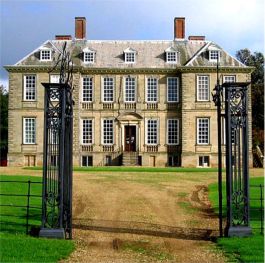 Some
country houses are
large and extremely grand, others small and unimposing. Stanford Hall is
certainly a house that stands out as a beautiful house with a strong
architectural facade, but not huge, nor small, rather a perfect size country
seat that is just perfection.
Some
country houses are
large and extremely grand, others small and unimposing. Stanford Hall is
certainly a house that stands out as a beautiful house with a strong
architectural facade, but not huge, nor small, rather a perfect size country
seat that is just perfection.Stanford Hall has been the home of the same family line since it was built by William Smith of Warwick for Sir Roger Cave in the 1690's. The house as you approach it down a long straight drive, has a very handsome stone front nine bay facade. It has two principle floors, garret rooms in the roof line and a semi basement service area. there are two slight protruding wings either side of the main block A simple stone set of steps leads up to what was the front door into the Stone Entrance Hall. This entrance later changed to give a Ball room in this front section of the house as I will describe in due course.
The entrance to the house today, is one side of the house with the drive sweeping round to it. You will notice that the house is only stone fronted, the side and rear elevations are of red brick, with stone dressings.
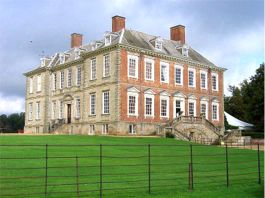
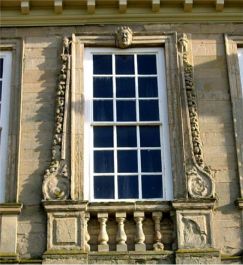
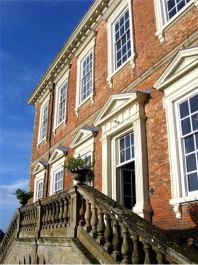
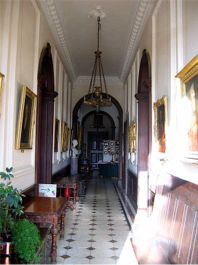 A double set of stone
steps with balustrade lead the visitor into the Marble Passage, a long
straight passage to the centre of the house where there is the grand 'Flying'
Staircase, named as such being an elegant cantilever construction.
A double set of stone
steps with balustrade lead the visitor into the Marble Passage, a long
straight passage to the centre of the house where there is the grand 'Flying'
Staircase, named as such being an elegant cantilever construction.
Having entered the Stone Passage, the guided tour of the house begins in the room on the immediate left, the Library. This room is used by the family during the winter months and is obviously one of the warmer rooms, the walls being lined about 5,000 books. This fine book collection has been assembled through the generations of the family and so includes very early books as well as more recent books including books for children. The dark wood panelling of the room gives it a masculine feel. The fireplace mantelpiece is also of the same type of dark wood with a black and white marble insert and iron grate. To the right of the fireplace hanging on the wall are some extremely interesting manuscripts, including William Smith's detailed account for the building of the house in the 1690's. The cost for building the house the princely sum of £2,137.10s.7d.
The Cave family originated from Yorkshire and farmed the tenanted land here, which then formed part of Selby Abbey, from 1430 until Henry VIII's dissolution the monasteries. Sir Thomas Cave purchased the land from Henry VIII in 1540 for the sum of £1,194.3s.4d and built a house away across the other side of the River Avon, which can be seen from the Library windows, on land near to the church. This was later pulled down when Sir Roger Cave built the house as we see it today.
The family has a quite unique peerage, allowed by Queen Victoria, for the Braye peerage to pass down the female as well as male line. Penelope Braye is the current Lady Braye, but she now resides in a house nearby. This house is now the home of her cousin Nicholas and his wife Lucy and their family.
Standing on a table within the Library are two very fine large Bible and Book of Common Pray, each with beautiful crimson silk covers that have been embroidered with silver thread. This embroidery was the work of Eleanor, daughter of Sir Thomas Cave, who married Sir Thomas Roe - a great traveller and diplomat. The books were given this special treatment as a thanks to God for the safe return of of the couple from a stormy voyage from Turkey, where the Pasha's improper advances to Eleanor had forced them to flee home to England.
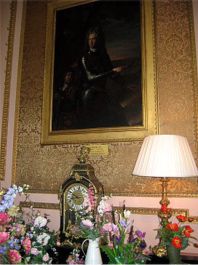
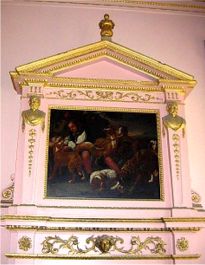 Leaving the Library and
turning left down the Stone Passage to the Stairway, a door to the left leads
into the Ball Room. This beautifully proportioned room takes up the entire
central bay of the front of the house between the protruding wings. This was
the original Entrance Hall to the house, which then had bedrooms above
it. However, in 1745, the 5th Baronet had it altered, increasing the height of
the room by doing away with the bedrooms above and introduced a coved ceiling.
The result is to provide a grand room for Balls and entertaining that is also
light and elegantly decorated. The walls have panelled sections in which there
are silk hangings and portraits.
Leaving the Library and
turning left down the Stone Passage to the Stairway, a door to the left leads
into the Ball Room. This beautifully proportioned room takes up the entire
central bay of the front of the house between the protruding wings. This was
the original Entrance Hall to the house, which then had bedrooms above
it. However, in 1745, the 5th Baronet had it altered, increasing the height of
the room by doing away with the bedrooms above and introduced a coved ceiling.
The result is to provide a grand room for Balls and entertaining that is also
light and elegantly decorated. The walls have panelled sections in which there
are silk hangings and portraits.
The coved ceiling of the room has its original decoration to the centre portion, this depicts Apollo in a sunburst in clever relief. There are also the original corner decorations to the coved ceiling in the form of trompe l'oeil shells. The painted panels between these shell corners is of later date from c1880's and are not of the same high quality.
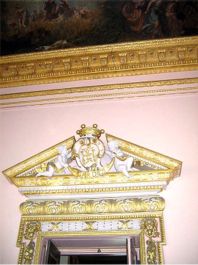
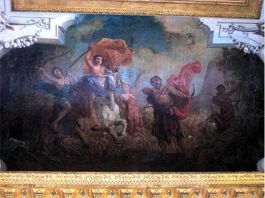
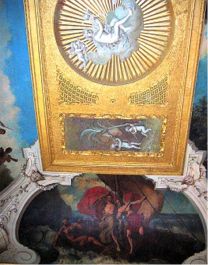
There are handsome chimney pieces within the room, with white marble fireplaces surrounded by moulded fire surrounds picked out with gilt decoration. Above are gilded caryatids supporting a triangular pediment topping a panel in which is an integral painting.
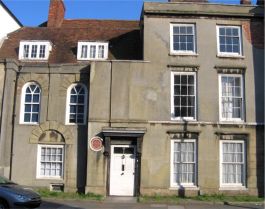
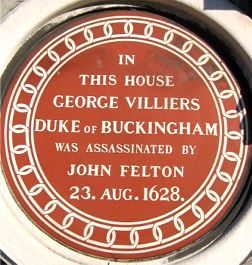 One portrait to the left
of the fireplace, is of George Villiers, 1st Duke of Buckingham, as Lord High
Admiral. He was assassinated in my home town of Portsmouth for having too much
influence as the King's favourite. A plaque commemorating this deed can be
seen on Buckingham House in the High Street, Old Portsmouth (see house left). Many of the other
portraits around the room were purchased by Sarah, Baroness Braye whist she
was in Rome from a sale of painting from the collection of Cardinal Duke of
York, who died in Rome in 1807.
One portrait to the left
of the fireplace, is of George Villiers, 1st Duke of Buckingham, as Lord High
Admiral. He was assassinated in my home town of Portsmouth for having too much
influence as the King's favourite. A plaque commemorating this deed can be
seen on Buckingham House in the High Street, Old Portsmouth (see house left). Many of the other
portraits around the room were purchased by Sarah, Baroness Braye whist she
was in Rome from a sale of painting from the collection of Cardinal Duke of
York, who died in Rome in 1807.On either side of the double doors from the Grand Staircase, are two magnificent marble topped side tables in the style of William Kent. On one of these tables stands a French Boulle clock form the early Eighteenth century. There is also a fine set of French saloon chairs with elegantly carved and gilded frames and gold silk upholstery.
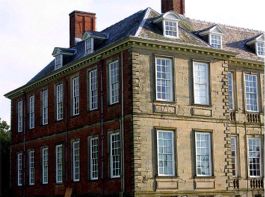 Turning to the right out
of the Ball Room leads one into; a charming room known as the Green
Drawing Room, this perhaps my favourite room of the house. The panelled walls
are painted in a subdued green, the panel shapes highlighted with gilding. A
plain white ceiling is elegantly embellished with plaster mouldings around the
edge. There are many fine paintings adorning the walls, including ancestors of
the family, as well as members of the Stuart monarchy. These include King
Charles I and Queen Henrietta Maria
Turning to the right out
of the Ball Room leads one into; a charming room known as the Green
Drawing Room, this perhaps my favourite room of the house. The panelled walls
are painted in a subdued green, the panel shapes highlighted with gilding. A
plain white ceiling is elegantly embellished with plaster mouldings around the
edge. There are many fine paintings adorning the walls, including ancestors of
the family, as well as members of the Stuart monarchy. These include King
Charles I and Queen Henrietta Maria
There are some delightful pieces of furniture in this room, including a small sized Queen Anne walnut bureau c1710, its upper section having a single plate glass mirror. In the centre of the room a very attractive George III satinwood oval breakfast table. On this table are a collection of porcelain bowls, some slops bowls from tea services, some English others oriental. Other very interesting items of tea wares can be seen in this room, for example on the mantelpieces stand a collection of Chinese tea bowls from the Eighteenth century.
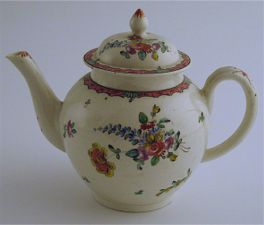 One of the most
fascinating items I spotted in this room was a miniature teaset from the
Caughley factory c1790. This charming tiny set comprised the teapot (rather
like the Worcester example illustrated here), as well as
tea bowls and saucers and milk jug etc. It is decorated with coloured enamel
painted flower sprigs. A rare item that was a joy to behold.
One of the most
fascinating items I spotted in this room was a miniature teaset from the
Caughley factory c1790. This charming tiny set comprised the teapot (rather
like the Worcester example illustrated here), as well as
tea bowls and saucers and milk jug etc. It is decorated with coloured enamel
painted flower sprigs. A rare item that was a joy to behold.
One of the finest pieces of furniture in the room is a German 17th century cabinet on gilt wood stand. The black framed cabinet contains six drawers, each with a glass panel fronts painted on the reverse side with Persian hunting scenes - quite spectacular.
Next to the Green Drawing Room is the Grey Drawing Room, another elegant and comfortable room that the family tend to use in the summer months. Like the Green Drawing Room the wood panelled walls are highlighted with gilt decoration, only this time the walls are painted a soft grey. On the wall to the right; a large group portrait showing three of the Children of King Charles I. These three are The Prince of Wales (later to become King Charles II), Prince James (later King James II) and Princes Mary. The room has an Adam fireplace above which; a rich floral painting by Jean Baptiste Bosschaert and dates from the 17th century. The painting has a wealth of beautiful flowers which overspill the vase, these include the sweet scented old fashioned roses and of course the valuable tulips.
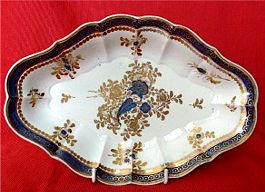 Dotted around the room
are pieces from a Caughley dessert service, including the kidney and lozenge
shaped dishes, these decorated in blue and gold, with simple French style
flower sprigs, similar to these from my web-site, c1790.
Dotted around the room
are pieces from a Caughley dessert service, including the kidney and lozenge
shaped dishes, these decorated in blue and gold, with simple French style
flower sprigs, similar to these from my web-site, c1790.
Next to the door of the room a very striking long cased clock with an extemporary English marquetry case. This clock was made for the family by Christopher Gould and is still in working order.
Leaving this room brings you back to the hall with the 'Flying' Staircase. this magnificent staircase was commissioned by Sir Verney Cave in 1730 and doubles back from a half landing to the second floor. The walls of the stairway are lined with many more of the families portraits through history. One interesting one is that of Sir Ambrose Cave wearing the Queen's garter! This came about when the Queen, Queen Elizabeth I, dropped her garter which was retrieved by Sir Ambrose. Upon offering it back to the Queen, she bade that he keep it, which he did and wore it round his arm.
Upstairs you can view two bedrooms, the first The Bachelors' Room which was originally a small dressing room and the South East Bedroom. This bedroom has recently been decorated with a light coloured wall fabric, making it look a very comfortable room. There is a Victorian four poster bed and on the walls hangs a 17th century Flemish tapestry showing a Roman battle scene. Furniture includes a lovely English chest of drawers with fine marquetry dating for the William and Mary period and a Dutch marquetry cupboard from the 18th century.
Returning down stairs via the east staircase, which was the original staircase of the house, the last room to be viewed is the Old Dining Room, now the Billiard Room. This room was the Dining Room of the house until the second world war when the Dining Room moved to a smaller room and this became the Billiard Room. There are some Tudor portraits in the room and also a few items of furniture that came from the original house that was demolished on the other side of the River Avon when this house was built. One of these items of furniture is the old oak refractory table.
Above the billiard table hung a 19th century French glass chandelier, until it was recently moved to hang in the Grand Staircase and replaced by a billiard table lamp, which is much more practical. In cabinets at one end of the room, some early items of clothing and other family memorabilia. There is a finely embroidered Gentleman's coat from the eighteenth century as well as a Queen Anne child's coat worn by the 4th Baronet.
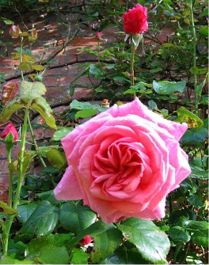
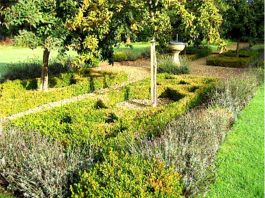
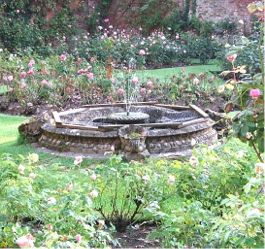
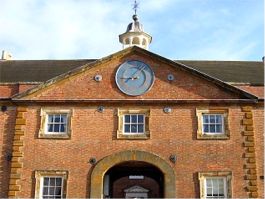 Concluding the visit to the house, I took a
short walk round the grounds, which are mostly parkland, with a small family
garden at the back of the house and rose garden within the stable block
courtyard. Also, within the courtyard are a few craft workshops, including one
making pottery items for sale, and an old blacksmiths where iron items are also
made for sale.
Concluding the visit to the house, I took a
short walk round the grounds, which are mostly parkland, with a small family
garden at the back of the house and rose garden within the stable block
courtyard. Also, within the courtyard are a few craft workshops, including one
making pottery items for sale, and an old blacksmiths where iron items are also
made for sale.
There is a tea room in the upstairs of the stable block. The house visitor numbers I do not believe to be very high, so the menu offered in the teashop is a little limited. However, there are sponge cakes, cream teas, tray bakes as well as simple sandwiches on offer and a nice way to end your visit to this most beautiful family country home.
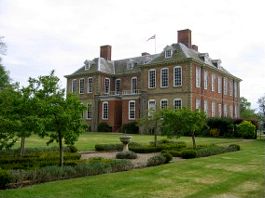
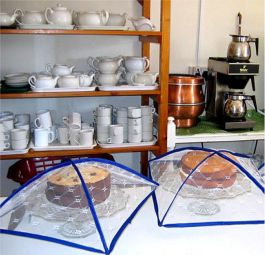
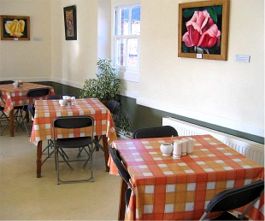
Stanford Hall
Lutterworth
Leicester
LE17 6DH
tel: +44 (0) 1788 860250
Local map:
Click here
Maps courtesy of
www.streetmap.co.uk
To review past newsletters, just follow this link:
Past newsletters.
To subscribe to this free newsletter -
Click here